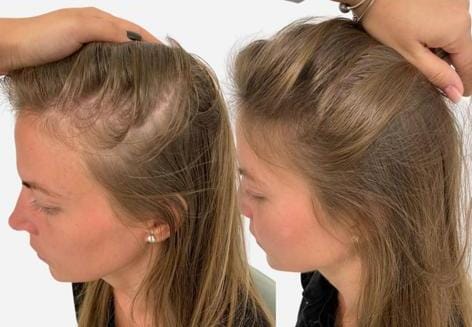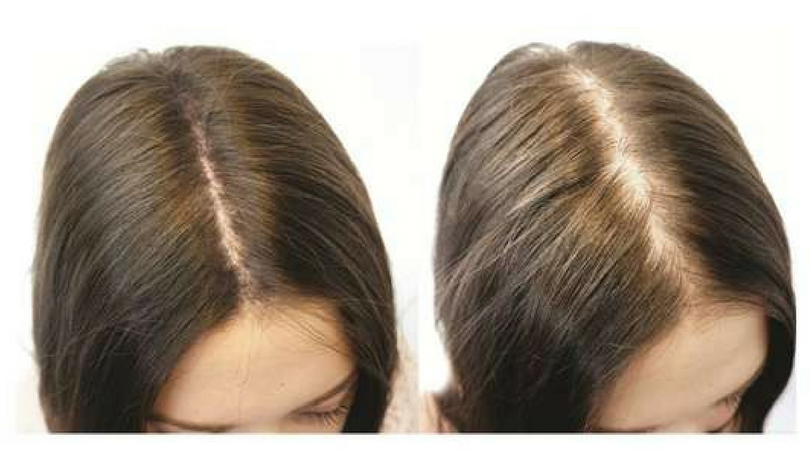Understanding Female Hair Loss: Causes & Treatment
Hair growth is affected by a wide range of factors, and although hair loss is an issue often associated with older men, many women are also confronted with reduced volume or hair thinning at some point in their lives. This can affect self-esteem and confidence, and is sometimes a symptom of other health issues that need addressing.
There are numerous causes of hair loss in women. Stress, lifestyle, diet, genetics, external surroundings, hormonal changes and medical issues can all be contributing elements to hair falling out or becoming thinner.
Around 70% of women over the age of 70 experience female-pattern hair loss (the most common type of hair loss) and 40% of women experience hair thinning after menopause1. Due to the ever-changing hormone levels throughout women’s lives, they are particularly vulnerable to some unique hair loss triggers attributed to hormonal change, such as pregnancy and menopause.
It is normal for men and women to shed a small amount of hair (around 100 hairs) on a daily basis. Hair loss or thinning occurs when certain triggers, such as those mentioned above, interrupt the hair growth cycle and more hair than usual enters the resting (shedding) phase – resulting in noticeable areas of loss.

Causes of Hair Loss in Women
The reasons for hair loss in women fall into a few key areas. Some causes are lifestyle-based, others are hormonal, and some are medical. Each woman may be affected differently; genetic predisposition also influences how the body responds to changes.
Not all changes to hair are permanent. If the hair follicle isn’t damaged and the hair loss isn’t a result of an internal medical issue (such as an autoimmune disease like alopecia areata), hair can grow back healthily once the imbalance is corrected3.
Age Related Hair Loss
Thinning hair and hair loss are often a normal part of aging, like going grey. Hair may become more brittle, the rate of growth slows, and hair follicles can shrink (affecting the density of each hair produced)4.
Hair loss in young women is less common, and is often part of the body’s response to a change or stress that it is being subjected to.
Hormonal Changes
Menopause affects each woman differently, but hair thinning is a common occurrence. A drop in oestrogen at menopausal stages can result in hair follicles falling out, while the remaining hair has less volume and density and is more prone to breakage.

Lifestyle Factors
Unless you have an existing medical condition, many of the lifestyle measures that keep the rest of your body healthy will also help your hair to grow healthily. Lifestyle causes for changes in the hair condition can usually be rectified.
Diet and exercise keep both hair and body in optimum condition. Get regular exercise and eat foods that contain plenty of the important nutrients for healthy hair growth – like iron, biotin and zinc – read more on the link between diet and hair loss.
Dehydration can affect the skin, including the scalp derma, and prevent hair from growing through properly – hair condition may also be affected.
Smoking, high alcohol consumption and other lifestyle choices can negatively impact your hair, since they affect overall health. They may contribute to dehydration, or restrict minerals from reaching the scalp for hair growth5.
Increased stress levels can result in hair falling out or thinning.
Hair styling and treatment – excessive strain from hairstyles6 or hair extensions, continued use of high heat, residue from hair products and a clogged scalp can all result in hair thinning or loss.

Female Pattern Hair Loss
When hair follicles produce hairs that cannot be seen, or ultimately shrink so much that they do not produce hair, this is known as female pattern hair loss (FPHL).
As with male pattern baldness, genetic predisposition is a factor. However, the effect in women is not usually as severe – women are less likely to go completely bald, but may see a receding hairline at the temples, forehead or back of the head7.
References:
https://www.nhs.uk/conditions/hair-loss/coping-tips-for-women/
https://www.nhs.uk/conditions/hair-loss
https://www.theguardian.com/lifeandstyle/2012/feb/06/female-hair-loss-causes-treatment
https://medlineplus.gov/ency/article/004005.htm
https://www.healthline.com/health/alcohol-and-hair-loss
https://www.bad.org.uk/shared/get-file.ashx?id=6323&itemtype=document
https://www.health.harvard.edu/staying-healthy/treating-female-pattern-hair-loss
https://www.nhs.uk/conditions/iron-deficiency-anaemia/ss/
https://dermnetnz.org/topics/female-pattern-hair-loss/
This post is also available in: Turkish




Leave a Reply
Want to join the discussion?Feel free to contribute!